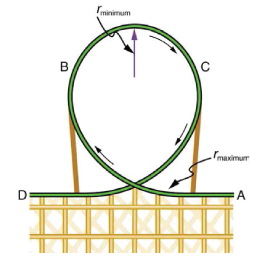Modern roller coasters have vertical loops like the one shown in the figure. The radius of curvature is smaller at the top than on the sides so that the downward centripetal acceleration at the top will be greater than the acceleration due to gravity, keeping the passengers pressed firmly into their seats. Part (a) What is the speed of the roller coaster, in meters per second, at the top of the loop if the radius of curvature there is 15 m and the downward acceleration of the car is 1.3g? Note that g here is the acceleration due to gravity. Part (b) The beginning of this roller coaster is at the top of a high hill. If it started from rest at the top of this hill, how high, in meters, above the top of the loop is this initial starting point? You may assume there is no friction anywhere on the track. Part (c) If it actually starts 3.5 m higher than your answer to the previous
Modern roller coasters have vertical loops like the one shown in the figure. The radius of curvature is smaller at the top than on the sides so that the downward centripetal acceleration at the top will be greater than the acceleration due to gravity, keeping the passengers pressed firmly into their seats.
Part (a) What is the speed of the roller coaster, in meters per second, at the top of the loop if the radius of curvature there is 15 m and the downward acceleration of the car is 1.3g? Note that g here is the acceleration due to gravity.
Part (b) The beginning of this roller coaster is at the top of a high hill. If it started from rest at the top of this hill, how high, in meters, above the top of the loop is this initial starting point? You may assume there is no friction anywhere on the track.
Part (c) If it actually starts 3.5 m higher than your answer to the previous part (yet still reaches the top of the loop with the same velocity), how much energy, in joules, did it lose to friction? Its mass is 1400 kg.

Trending now
This is a popular solution!
Step by step
Solved in 3 steps with 1 images









